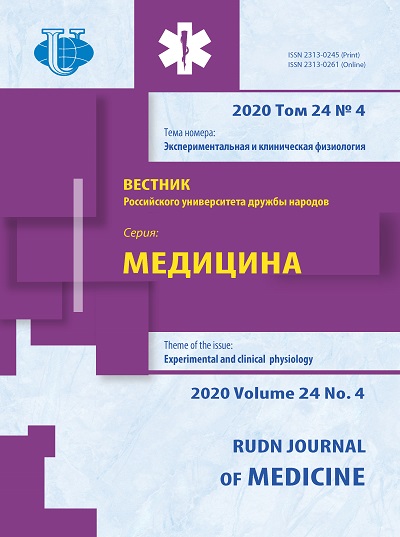Effect of supraspinal influences on the manifestation of presynaptic inhibition Ia afferents in different types of muscle contraction in humans
- Authors: Bogdanov S.M.1, Gladchenko D.A.1, Roshchina L.V.1, Chelnokov A.A.1
-
Affiliations:
- Velikie Luki State Academy of Physical Education and Sports
- Issue: Vol 24, No 4 (2020): EXPERIMENTAL AND CLINICAL PHYSIOLOGY
- Pages: 338-344
- Section: CLINICAL PHYSIOLOGHY
- URL: https://journals.rudn.ru/medicine/article/view/25028
- DOI: https://doi.org/10.22363/2313-0245-2020-24-4-338-344
Cite item
Full Text
Abstract
Relevance. Тhe biological role of presynaptic inhibition is to regulate excessive skeletal muscle tone, which prevents the execution of arbitrary muscle contractions. In the modern literature, there is information devoted mainly to the study of various types of spinal inhibition in the isometric type of contraction. The aim: determining the role of supraspinal influences from brain stem structures on the activity of presynaptic inhibition when performing various types and sizes of muscle contractions in humans. Materials and methods: 20-22 year-old healthy men (n=6) took part in the research. Presynaptic inhibition was registered at rest; at rest in combination with the performance of Jendrassik maneuver; when performing concentric, eccentric, isometric contractions of 50 % and 100 % of the individual maximum without and against the background of Jendrassik maneuver. Results: During the execution of concentric, eccentric and isometric contractions of different sizes, the severity of presynaptic inhibition decreases in comparison with rest, both without taking Jendrassik maneuver, and against the background of its execution. With an increase in the strength of concentric, eccentric, and isometric contractions from 50 % to 100 % of the individual maximum, the severity of presynaptic inhibition progressively decreased under the same experimental conditions. Without taking Jendrassik maneuver, the greatest severity of presynaptic inhibition was observed with concentric and isometric contractions of 50 % and 100 % of the MVC, and against the background of taking Jendrassik maneuver - with an isometric type of reduction of 50 % and 100 % of the MVC. Conclusion. Supraspinal descending effects caused by the Jendrassik maneuver modulate the state of presynaptic inhibition Ia of the afferents of the flexor muscle of the foot, depending on the type and strength of muscle contraction.
About the authors
S. M. Bogdanov
Velikie Luki State Academy of Physical Education and Sports
Author for correspondence.
Email: and-chelnokov@yandex.ru
SPIN-code: 2076-9689
Velikie Luki, Russian Federation
D. A. Gladchenko
Velikie Luki State Academy of Physical Education and Sports
Email: and-chelnokov@yandex.ru
SPIN-code: 7541-0760
Velikie Luki, Russian Federation
L. V. Roshchina
Velikie Luki State Academy of Physical Education and Sports
Email: and-chelnokov@yandex.ru
SPIN-code: 6287-8630
Velikie Luki, Russian Federation
A. A. Chelnokov
Velikie Luki State Academy of Physical Education and Sports
Email: and-chelnokov@yandex.ru
SPIN-code: 4706-8513
Velikie Luki, Russian Federation
References
- Bikmullina R.H., Rozental’ A.N., Pleshchinskij I.N. Tormoznye sistemy spinnogo mozga v kontrole vzaimodejstvij funkcional’no sopryazhyonnyh myshc. Fiziologiya cheloveka. 2007;33(1):119– 130. (In Russ).
- Chelnokov A.A., Gladchenko D.A., Fedorov S.A., Gorodnichev R.M. Vozrastnye osobennosti spinal’nogo tormozheniya skeletnyh myshc u lic muzhskogo pola v regulyacii proizvol’nyh dvizhenij. Fiziologiya cheloveka. 2017;43(1)35–44. (In Russ).
- Pierrot-Deseilligny E., Burke D. The Circuitry of the Human Spinal Cord: Spinal and Corticospinal Mechanisms of Movement. United States: Cambridge University Press. 2012. 606 p.
- Moreno-López Y., Olivares-Moreno R., Cordero-Erausquin M., Rojas-Piloni G. Sensorimotor Integration by Corticospinal System. Front Neuroanat. 2016;9:10–24.
- Rudomin P., Schmidt R.F. Presynaptic inhibition in the vertebrate spinal cord revisited. Exp. Brain Res. 1999;129:1–37.
- Rudomin P. In search of lost presynaptic inhibition. Exp. Brain Res. 2009;196(1):139–151.
- Popova I.E., Sysoev A.V. Funkcional’nye osobennosti N-refleksa sportsmenov razlichnyh specializacij v godichnom cikle trenirovok. Uchenye zapiski universiteta imeni P.F. Lesgafta. 2015;4(122):156– 159. (In Russ).
- Earles D.R., Dierking J.T., Robertson C.T., Koceja D.M. Preand post-synaptic control of motoneuron excitability in athletes. Journal of Med. Sci. Sports Exerc. 2002;34:66–72.
- Gurfinkel’ V.S. Priem Endrassika sozdaet usloviya dlya zapuska neproizvol’nyh shagatel’nyh dvizhenij. Fiziologiya cheloveka. 2000;26(2):73–79. (In Russ).
- Yafarova G.G., Baltina T.V., Pleshchinskij I.N. Funkcional’no e sostoyanie dvigatel’nyh centrov spinnogo mozga v usloviyah ego travmaticheskogo povrezhdeniya. Nizhnekamsk: Izd-vo NF MGEI. 2008. 74 p. (In Russ).
- Knikou M. The H-reflex as a probe: Pathways and pitfalls. Journal of Neuroscience Methods. 2008;171:1–12.
- Selionov V.A. Tonic central and sensory stimuli facilitate involuntary air-stepping in humans. J. Neurophysiol. 2009;101(6):2847–2858.
- Selionov V.A. Lack of non-voluntary stepping responses in Parkinson’s disease. Neuroscience. 2013;235:96–108.
- Sylos-Labini F. Locomotor-like leg movements evoked by rhythmic arm movements in humans. PLoS One. 2014;9:3: e90775.
- Chelnokov A.A., Buchackaya I.N. Funkcional’nye osobennosti spinal’nogo tormozheniya cheloveka pri proizvol’noj dvigatel’noj aktivnosti. Teoriya i praktika fizicheskoj kul’tury. 2015;6:11–13. (In Russ).
- Chelnokov A.A., Koshkarev L.T., Chelnokova M.I. Osobennosti spinal’nogo tormozheniya pri proizvol’noj dvigatel’noj aktivnosti myshc goleni u lic, zanimayushchihsya fizicheskoj kul’turoj i sportom. Sportivnaya medicina: nauka i praktika. 2017;7(1):5–13. (In Russ).
- Mizuno Y., Tanaka R., Yanagisawa N. Reciprocal group I inhibition of triceps surae motoneurones in man. Journal of Neurophysiology. 1971;34:1010–1017.
- Jendrássik E. Beiträge zur Lehre von den Sehnenreflexen. Deutsche Archiv für Klinische Medizin. 1883;33:177–199.
- Zehr E.P., Stein R.B. Interaction of the Jendrássik maneuver with segmental presynaptic inhibition. Exp Brain Res. 1999;124:474– 480.
- Dowman R., Wolpaw J.R. Jendrassik maneuver facilitates soleus H-reflex without change in average soleus motoneuron pool membrane potential. Exp Neurol. 1988;101(2):288–302.
- Gregory J.E., Wood S.A., Proske U. An investigation into mechanisms of reflex reinforcement by the Jendrassik manoeuvre. Exp Brain Res. 2001;138:366–374.
- Gladchenko D.A., Chelnokov A.A., Drobysh A.S. Vliyanie nespecificheskoj aktivacii stvolovyh struktur golovnogo mozga na vyrazhennost’ presinapticheskogo tormozheniya pri proizvol’nyh dvizheniyah. Materialy XXIII s»ezda Fiziologicheskogo obshchestva imeni I.P. Pavlova. Voronezh: Izd-vo «ISTOKI». 2017. P. 2025–2026. (In Russ).
















